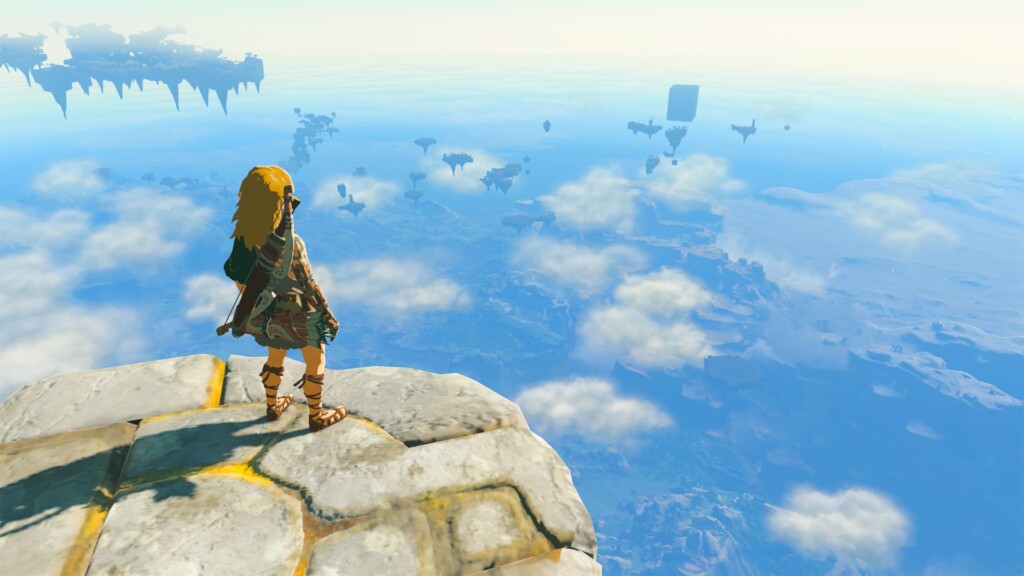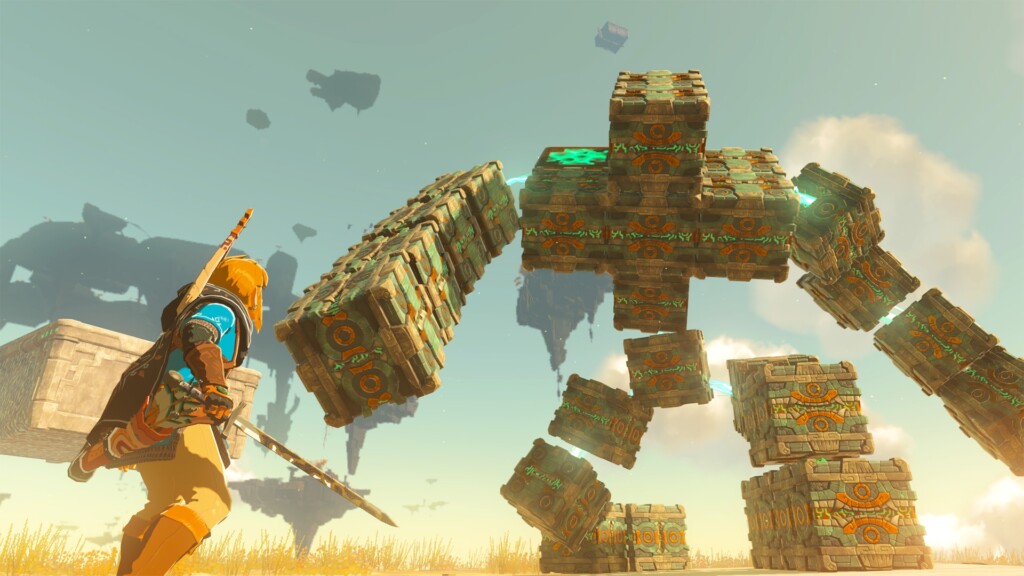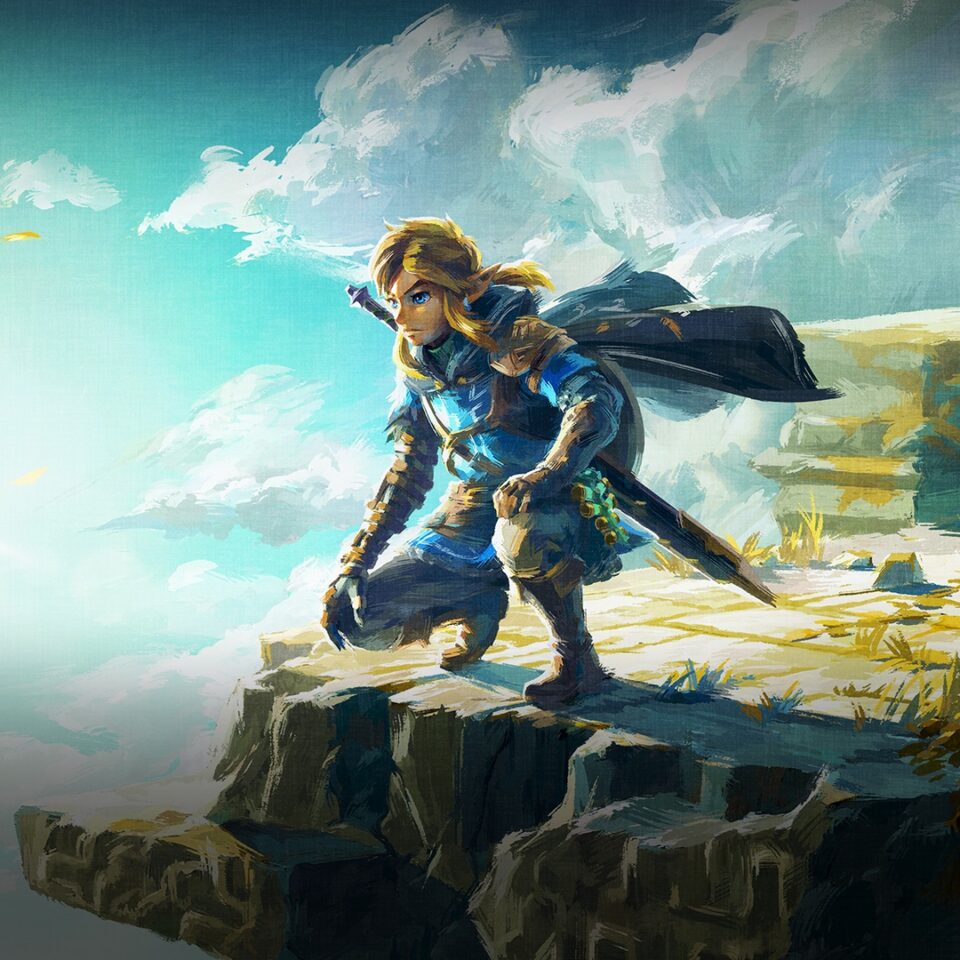Is it dangerous to reuse an open world? Take this.
The Legend of Zelda: Breath of the Wild begins with Link emerging from the Shrine of Resurrection to discover the land of Hyrule spread out before him. Echoing Link’s departure from Kokiri Forest in The Legend of Zelda: Ocarina of Time, the moment tantalises with a vista that promises adventure, danger, and exploration.
The Legend of Zelda: Tears of the Kingdom continues the tradition with a similar escape. This time, as Link emerges into the light, the view is from up high. It’s a new perspective of Hyrule, now laid out thousands of metres below. Adventure is promised once again, but Nintendo understands the risk of reusing the same open world that we scoured for secrets six years ago. The new perspective acknowledges that players have been here before. Familiar locations serve as a recap of Breath of the Wild. You’ve mapped, conquered, and explored this land. As the game begins, you’re on top of the world in every sense.
But Hyrule has had a literal upheaval. The new vantage point shows that disruption, with chunks of the world torn from the ground and now floating impossibly among the clouds.

The Sky
As it turns out, the sky is not as vast as the game’s early promos might have indicated. Although it expands considerably on The Legend of Zelda: Skyward Sword‘s limited and sparsely populated overworld, Nintendo has opted for intricate and discrete play boxes instead of sprawl.

Link’s adventures unfold like a 3D Mario game. Physics puzzles, platforming, and perilous feats of derring-do are set against the ever-present risk of a 10,000ft tumble. The stormy ascent to one of the game’s temples is like Super Mario 64‘s Rainbow Ride writ large, and the negotiation of another echoes the gravity-blending exploits of Super Mario Galaxy. However, the sky also offers respite and tranquillity. There’s no better place to soak up the glow of a setting sun or any other atmospheric masterpiece that Nintendo’s skybox technology can provide.
There’s also more connective tissue to the world below. Unlike Skyward Sword, there are no canned transitions as you move between the sky and the surface. Instead, Link takes a thrilling and seamless dive through the clouds, touching down on the ground (and sometimes beyond) in moments. The exhilarating journey down makes a mockery of the Nintendo Switch’s age and power.

The Surface
With your feet on terra firma, it’s clear that the Upheaval hasn’t been the only factor in rearranging pieces Hyrule. The Hyrulians, Gorons, Rito, and Zora have all been hard at work since the events of Breath of the Wild. Locations have evolved, towns developed, and surprises are hidden in every corner. There’s a clear sense that time has passed and the society is attempting to re-establish itself.

There was a fear that reusing Breath of the Wild‘s location would be a mistake, but Nintendo has made great efforts to make the familiar feel new. Structurally, the game is built on familiar elements. However, Link’s new powers, particularly Ascend and Ultrahand, have a transformative effect on your interaction with the game’s challenges and environment. Hyrule’s familiarity ends up being one of Tears of the Kingdom‘s biggest strengths – there’s a constant joy in using the new powers to view the world from new perspectives.
Shrines are hidden out of sight, with many only revealed once a side quest is completed. Wishing wells and caves are peppered across the land, teasing Link with treasures and secrets. Every task you take offers a tangible reward, but they also provide an opportunity to learn more about the world. The scale and variety that impressed so much in 2017 remain intact, but there’s much more to discover, more to take you off the critical path, and more emergent experiences to lose yourself in.

The Depths
Deep down, below the surface, are the Depths. It’s unexplored territory and almost unexplorable. Pitched in darkness, the Depths are discomforting by design. Every inch needs illumination, either through the distribution of Brightbloom Seeds (another collectable from the world above) or the discovery of Light Roots, huge gnarled trucks that grow from the ground and cast light over larger areas.

Uncovering the depths is an effort in resilience. Twisted versions of the familiar creatures – and some dastardly new creations – are an ever-present threat. The fungal-like fauna and particles that eerily hang in the air evoke queasy trips into the human body from films like Fantastic Voyage and Inner Space.
It’s an infected, unknowable space. Unknowable, that is, until you recognise the characteristics it shares with the world above. Each tier of the kingdom offers different flavours of adventure, but each is also connected. Eventually, your knowledge of the surface and sky informs your forays into the gloom, lighting the way forward.

The Hero’s Journey
Throughout your journey, you’ll discover well over a hundred new shrines, each ingenuously using Link’s new powers in creative ways. You will encounter familiar faces and new NPCs. You will fight against new enemies, including some of the most formidable foes ever seen in a Zelda game. You’ll run errands, build your own home, participate in a town election, help in running a newspaper, and conquer some stunning new temples. You’ll also assemble a museum of monsters, compete in a strongman competition, acquire a mech-suit, and more and more and more.
The Legend of Zelda: Tears of the Kingdom is the kitchen sink of kitchen sinks. And yet, it all hangs together without a bug in sight. The game is a complex web of interconnected systems that coalesce into a consistent, coherent and utterly memorable adventure. It even manages to include the most emotionally resonant story in the series to date.

From the plaintive cry of “There’s my friend!” as you reunite two Koroks to a furious battle with a King Gleeok in the pits of hell, The Legend of Zelda: Tears of the Kingdom is in equal parts epic and intimate. Where Nintendo goes from here is anyone’s guess. Across two games and a combined 400-plus hours of play time Nintendo has created an experience that blends genres and allows an overwhelming sense of freedom to discover and create. Another trip to this Hyrule might be one too many, but I wouldn’t rule Nintendo out. Hopefully, they’ll flood the place and make a follow-up to The Wind Waker.
What is a long-term review?
Rather than rushing to review a game around its release, sometimes it’s preferable to take your time and evaluate the experience as a whole. In this case, we’ve reviewed The Legend of Zelda: Tears of the Kingdom just over six months after its release, after playing the game for nearly 200 hours.
Game: The Legend of Zelda: Tears of the Kingdom
Platform: Nintendo Switch
Developer: Nintendo
Publisher: Nintendo
Release Date: May 12, 2023






